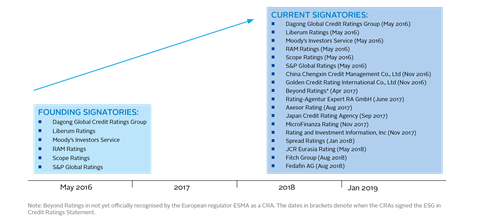This report rounds off a series of three as part of the PRI’s ESG in Credit Ratings Initiative, which started with the launch of the ESG in Credit Ratings Statement in May 2016.
Signatories to the statement publicly state their recognition of the value of considering ESG factors transparently and systematically in credit risk analysis.
The rapid growth in number of signatories to the statement is a testament to how quickly this topic is gaining traction; to date 146 investors globally have signed, managing US$29 trillion collectively (see below). Even more impressive has been the trebling of participating CRAs (see below).

The statement – which remains open to new signatories – has served as an important incentive for credit analysts (from investors and CRAs) and FI portfolio managers to engage on ESG topics at such scale and regional breadth through the forums that the PRI has organised. These forums have facilitated a purposeful dialogue, providing participants with the time and space to share progress and challenges in their approach to ESG consideration.
The statement has also encouraged investors and CRAs to engage more actively with issuers, industry representatives, regulators and non-governmental organisations (NGOs) to raise awareness about the goals of the initiative and promote its progress.

Progress has accelerated in recent years: some of the most established CRAs have been leading the pack, but many regional players have also made notable efforts. Importantly, in a very short time frame, commitment to the statement has catalysed significant organisational changes at many CRAs, including the establishment of dedicated analyst teams, the creation of web pages to share ESG-related articles and increased transparency as to how they integrate ESG consideration into their methodologies. The latter two developments were viewed as “positive steps forward” by the European Securities and Markets Authority (ESMA).
The initiative has also drawn attention to new agencies – some of which are not regulated yet – that provide ESG risk assessments or augmented analyses of creditworthiness i.e. with the explicit inclusion in their methodology of sustainability indicators.
The table below provides a snapshot of the areas in which CRAs have made visible progress since the start of the initiative. Individual rating examples are in the section CRA examples.

All three large, global CRAs have published notes explaining how ESG factors are considered in their methodologies. Furthermore, ESG-related literature is expanding rapidly and is well documented on the respective CRA ESG web pages. Some recent publications are particularly noteworthy, including:
- Fitch Ratings, which was relatively late to join the PRI ESG in Credit Ratings Initiative, launched an integrated scoring system as part of its credit rating research in January 2019. The system shows how ESG factors impact individual non-financial corporate credit rating decisions and enables investors to agree or disagree with the way Fitch has treated ESG factors at both an entity and a sector level.
- Moody’s Investors Service updated its environmental risk heat map in September 2018, highlighting the sectors with elevated, medium and low credit exposure and changes in relative environmental risk scores since 2015. Moreover, it has requested feedback on its general principles for assessing ESG risks and its proposed framework for the corporate governance assessment of publicly-listed non-financial corporates.
- S&P Global Ratings completed a trilogy of reports dedicated to clarifying how environmental and climate, social, and management and governance risks and opportunities factor into its global corporate ratings, and published the same analysis for its sovereign, insurance and financial institution ratings, based on a review of past rating actions, including changes to rating outlooks.
This report and part one and two – describing the state of play of ESG consideration in credit risk analysis and exploring the areas where investors and CRAs appeared to have different views at the start of the dialogue, respectively – are also milestones of the initiative.
Download the report
-

Shifting perceptions: ESG, credit risk and ratings: part 3 - from disconnects to action areas
January 2019
ESG, credit risk and ratings: part 3 - from disconnects to action areas
- 1
- 2
 Currently reading
Currently readingFostering CRA-investor dialogue
- 3
- 4
- 5
- 6
- 7
- 8
- 9
- 10
- 11
- 12
- 13
- 14
- 15
- 16
- 17
- 18
- 19
- 20
- 21
- 22
- 23
- 24
- 25


































